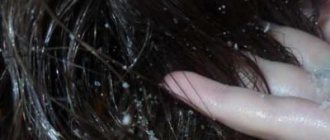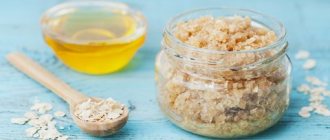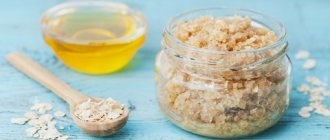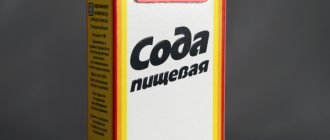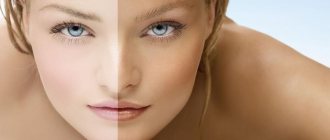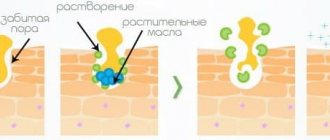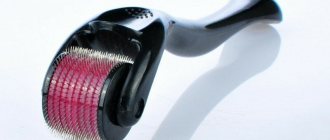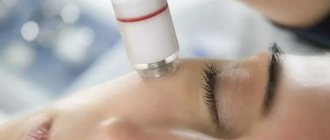Only babies can have ideally soft heels, because they have not yet stood on their feet. As we grow older, the skin on our feet becomes rougher. This occurs due to tight shoes, dehydration, and walking barefoot. In short, there are a lot of reasons. But I really want to find an effective way to soften the rough skin of my feet and have soft feet like a baby’s.
What is a scrub
The word "scrub" is derived from "scrape".
The main function of a scrub is to scrape off the stratum corneum of the skin with abrasive particles. Depending on the components of the composition, it can also moisturize, nourish and increase skin elasticity.
The main indications for use are dryness and flaking.
Causes of dryness:
- Violation of drinking regime . To maintain normal functioning of the body, an adult should drink at least 1.5 liters of clean water. If this rule is violated, the skin will be the first to report a lack of moisture;
- Long water procedures . A long hot bath can also cause excessive dryness. By the way, wrinkled skin after a long stay in water is an indicator that liquid has been “sucked” out of the skin;
- Poor nutrition . The main component of healthy skin is the presence of essential vitamins and microelements in the foods consumed. Without this, even an expensive drug will not help you achieve velvety legs;
- Reduced number of sebaceous glands . The feet and legs are initially more dry than other areas of the skin. The main reason for this is the small production of sebaceous secretion.
Eliminate all causes of possible dryness and enjoy improved skin condition on your feet, and regular scrubbing will help you maintain the effect.
Action:
- Removing dead cells and combating flaking
- Using a product with abrasive particles helps improve blood circulation, saturate it with oxygen and start the renewal of skin tissue;
- Prepares the skin for contact with nourishing oils or creams. Open and cleansed pores absorb beneficial components better;
- Helps fight ingrown hairs after depilation.
Differences between scrub and peeling
It is a misconception to believe that scrub and peeling are the same product. The only similarity between these products is their cleansing function. Initially, peeling is any procedure aimed at removing the stratum corneum, while a scrub is a mechanical type of peeling. After the appearance of products called “peeling”, the scrub remained a mechanical option, and the new product was characterized as a liquid composition with a high acid content. What is the difference between peeling and a regular scrub?
Main differences:
- Depth of impact . The action of the scrub is aimed at eliminating external defects - peeling and dryness. Peeling penetrates much deeper and carries out a “thorough” cleaning;
- Effect . The scrubbing preparation, due to its aggressive effect on the skin, shows instant results, but is rather short-lived - you will need to repeat the procedure once a week. Peeling involves the deep layers of the skin, so the cleansing result lasts for about a month.
- Allergenicity . The use of a scrub is less likely to be accompanied by allergic reactions due to its surface action. Aggressive peeling components of mineral or chemical origin are much more often accompanied by rashes and itching.
- Safety . But it is much easier to damage the skin with hard abrasive particles. If the abrasive particles are too large and sharp, micro wounds and cuts will remain on the surface.
Peeling for feet - we explain the types and technologies
Users' opinions
- EllenFrolo . So far, of all the scrubs I've tried, Savonry has proven to be the best.
- First of all, it exfoliates perfectly.
Secondly, it does not injure my skin.
Usually I first steam my feet in a bath with essential oils, and then scrub. The effect is excellent and lasts a long time. Over the summer, I may end up with more than one package, because I love open-toed shoes, and the roads in our city leave much to be desired.
Scrubbing your feet helps eliminate flaking and dead skin, leaving it soft and silky. You can prepare the scrub yourself, or you can purchase a finished product at a cosmetic store. The main thing is the presence of caring components and not too aggressive abrasive.
Rules of application
To achieve the best scrubbing effect:
- Before the procedure, it is recommended to prepare a bath and steam the skin. It is best to use water with the addition of chamomile, sage, essential oils or sea salt for these purposes.
- Apply the required amount of product to wet feet and distribute it with light massage movements. The movement is carried out from the heel with a gradual transition to the toes. The drug, rich in useful substances, can be left for 5-10 minutes and only then rinsed off with warm water.
- Lubricate your feet, legs and toes with moisturizing cream.
It is recommended to carry out the procedure before bedtime so that the nutritional components have time to penetrate deeper and moisturize thoroughly.
Types of use
- As an independent remedy to combat dryness and flaking;
- As an additional stage of the SPA procedure;
- To improve the effect of massage;
- As a preparatory stage before a pedicure;
Massage
The use of compounds with abrasive particles is an excellent addition to the main steps of massage.
Using a scrub allows you to:
- Improve blood flow;
- Start the regeneration of skin cells;
- Allow the massage oil to penetrate deeper and produce a moisturizing effect.
How to use for massage:
- Lightly steam the legs in a warm bath with herbs or oils;
- Apply a small amount of scrub to the desired area;
- Distribute with circular movements, from top to bottom, from heel to toes;
- Massage for 10-15 minutes, then rinse off the composition with water and continue the massage using oil or lotion.
Pedicure massage: benefits, features and procedure for performing the procedure
A couple of tips:
- You should not scrub your feet for more than 15 minutes. Prolonged contact with abrasive particles of the drug can damage the skin;
- For massage, it is better to choose a product with a finely ground abrasive to prevent injuries and micro scratches.
Pedicure
It is difficult to imagine a complete foot care procedure without thoroughly cleansing the skin. A scrub will help in the fight for cleanliness and velvety. The product is perfect for both regular, dry pedicure and spa pedicure.
How to use in a spa pedicure procedure:
- Prepare a warm bath and steam the skin for 10-15 minutes;
- Apply a small amount of scrub to your feet and spread it over your feet with light movements;
- Massage for 3-5 minutes, paying special attention to the heel and toes. To enhance the effect, you can use pumice stone together with the scrub.
- Rinse off the mixture, dry your feet and start working on your nails.
Dry pedicure: European and hardware options
For dry pedicure:
- Thoroughly disinfect your feet with an antiseptic;
- Apply the scrub and rub it in in a circular motion for a few minutes. Particular attention is paid to problem areas - heels, toes and lateral surface of the foot;
- Remove residues with a dry cloth or towel;
- Start working on your nails.
In this case, the scrub works as a substitute for a foot grater. The main thing is to choose a product suitable for use on a non-steamed surface.
Varieties
According to the purpose of use, scrubs are:
- To combat hyperhidrosis .
Some components help not only with removing the stratum corneum, but also to reduce sweating. Sea salt, mint essential oil, sage or lavender in the composition will have an antimicrobial and antiseptic effect and reduce the production of secretions; Hyperhidrosis of the feet: causes and solutions to the problem - To eliminate heaviness;
- Nutritious . Active moisturizing agents in the composition help saturate the skin with moisture and prevent the appearance of cracks.
Depending on the area of application , foot scrubs can be divided into 2 types:
- For the feet . Includes large abrasive particles that skillfully cope with corns and keratinization. It is dangerous to use such a product on other parts of the body - thin skin can be easily damaged by sharp components;
- For ankles and shins . A more gentle option with reduced “scraping” particles. This product cannot cope with a thick layer of keratinization, but it will gently scrub sensitive skin.
How to get rid of rough skin at home
You can entrust the removal of rough skin to a professional or do it yourself at home. In the second case, you will need the following tools:
- Abrasive file for feet : roller or standard fine-grained grater.
- Scrub : We recommend natural salt-based scrubs, as they have an anti-inflammatory and restorative effect, while simultaneously cleansing and softening the skin.
- Moisturizing or nourishing foot cream : pay attention to products with aloe, panthenol, shea butter and shea butter.
- Foot bath : salt and oils in the bath take care of the skin, relieve fatigue and swelling, promote the healing of calluses, and also prepare the feet for exfoliation.
- Moisturizing socks or foot mask : an optional but very pleasant foot care product that moisturizes and softens calluses.
To summarize, we can distinguish 5 main stages of caring for rough skin on the feet.
Contraindications
The relative safety of the scrub does not deprive it of a number of restrictions on its use.
- Phlebeurysm. If there are pronounced spider veins and enlarged veins in the treated area, the use of cleaning with abrasive particles is prohibited;
- Individual intolerance to the abrasive effect. If the skin reacts to the drug with even greater dryness, redness or rashes, it is better to abandon this method of cleansing;
- Close location of capillaries.
Closely located vessels may react unpredictably to abrasive particles; Proximity of blood vessels: features of the choice of manicure and cuticle care - Allergy. Especially relevant for home scrubs. Before applying a new drug, check for the presence of an allergic reaction. To test, apply a small amount of product to a small area and leave for 30-40 minutes.
Possible side effects
If foot scrubs are used incorrectly or too frequently, side effects may occur:
- Minor cracks and scratches . Most often this happens when using an abrasive that is too large or hard, or when applying excessive pressure to the skin during the procedure.
- Redness . If your scrub contains fruit acids or vinegar, don't be surprised when your skin turns red after using the product. Redness usually subsides 1–2 hours after the procedure.
- Allergic reaction. Individual intolerance to individual components from the composition can always appear unexpectedly. It usually manifests itself in the form of a rash, itching or redness.
The best ready-made scrubs
Org anic Shop Polishing foot scrub “Glass slipper”
The salt crystals in the composition do an excellent job of mild peeling and mild keratinization of the feet. With a jar volume of 100 ml. It is used sparingly. The package is enough for 8-10 uses.
Price – from 70 to 130 rubles.
ARAVIA Professional, Salt & Aroma scrub
Aravia salt foot scrub contains tropical verbena and tea tree oils, thanks to which it has a decongestant, antiseptic and spasmodic effect. Also among the functions of the scrub:
- Acceleration of tissue regeneration;
- Saturation of the skin with vitamins;
- Smoothing effect;
- Relieving leg fatigue.
The product is intended for professional use. One procedure requires 6-8 grams of product. Apply the product to damp skin of the feet and legs.
Farmona, Grapefruit Salt Peeling Smooth Feet
Another professional product is Farmona foot scrub. Salt crystals act as an abrasive, and the caring effect is achieved through shea butter, as well as grapefruit squeeze and extract.
The product is applied with massage movements to slightly damp skin of the feet. It is important that it is recommended to use the scrub after a hardware pedicure and after coating. This is due to the oils in the composition - they will ruin the adhesion between the material and the nail.
Avon, Pineapple and Tea Tree
Avon Foot Scrub gently removes dry skin particles and dead cells. It has a pleasant aroma and effectively moisturizes the skin of the feet. Contains tea tree oil, which has an antiseptic effect and prevents the development of mycoses.
Avon Foot Works “Lime Mojito”
The product promotes high-quality cleansing of the stratum corneum and deep moisturizing of the skin. It has small abrasive particles and is used for both feet and ankles.
Package volume – 75 ml. Average price – 70 rub.
Avon Foot Works Sea Salt Toning
Cools, fights heaviness and effectively cleanses the feet. The gel texture of the scrub is perfectly distributed.
Price for 75 ml – from 80 to 100 rubles.
Faberlic foot scrub ETNO botanica series
Abrasive particles in the form of crushed apricot kernels do an excellent job even with old keratinization. In addition to its main function, the product tones and gives lightness.
Standard tube 75 ml. will cost 100 rubles.
Scholl Foot Scrub
The manufacturer of pedicure instruments has expanded its line with a scrubbing product. Pumice particles are used as an abrasive, which effectively removes unwanted particles. A significant drawback is the unpleasant smell.
Volume 75 ml, costs an average of 250 rubles.
One hundred beauty recipes “Flower honey and apricot kernels”
After using the product, the legs become soft and tender due to the honey in the composition. Copes perfectly with dryness and moderate flaking.
Standard packaging 75 ml. Price – from 70 to 110 rubles.
Foot scrub Natura Siberica Volcanic
Carefully removes keratinized areas and saturates with moisture. The composition contains volcanic pumice, thermal water and salt crystals.
Volume – 150 ml. Price – from 400 to 600 rubles.
Sally Hansen Foot Polish Scrub
Pumice particles, lavender extract and tea tree oil effectively clean and disinfect. When used systematically, it has a deodorizing effect.
Tube volume – 75 ml. The average price is 350 rubles.
Causes of rough skin on heels and feet
The feet are our support and every day the feet bear the entire load of the body. Just imagine how much they have to endure: walking barefoot on hot sand, heels, stuffy shoes, dancing, sports. Under pressure, the skin grows a stratum corneum to protect against damage. This is what we are trying so hard to get rid of. Under a dry and dense layer of rough skin, our feet are tender and soft.
What causes rough feet and heels?
- Body weight, even if it is within the normal BMI - body mass index.
- Shock load from any activity. When dancing, walking, running, our feet take the impact, and when we jump, they bear a load 8 times our weight.
- Dehydration. Lack of fluid = dry and rough skin.
- Hormonal changes during lactation and menopause make the skin drier.
- Walking barefoot on the seashore, sand and salt water draws moisture from the feet.
- Thick synthetic socks and shoes that don't fit properly interfere with blood circulation.
- Using an overly hard file or cutting off the roughened part “under the root” leads to the opposite effect: the skin is protected and the stratum corneum grows even more actively.
- Improper foot care. It is important to regularly cleanse, steam and moisturize your skin.
- Vitamin deficiency, which is most active in the cold season.
The condition of the feet also serves as an indicator of well-being. The appearance of rough skin can cause various health problems:
- Estrogen deficiency. Constant peeling of the skin of the feet and the appearance of cracks with proper care is a reason to visit an endocrinologist and take a blood test. Estrogen levels have a great influence on a woman’s beauty and the speed of skin regeneration. When it is low, corns, rough skin on the heels and cracks appear, which can become inflamed.
- Thyroid gland dysfunction. If you are overweight, the wounds on your feet are not healing well, and your skin is peeling, this may indicate hypothyroidism - a decrease in thyroid function. This syndrome affects the production of hormones, fat and carbohydrate metabolism, and can provoke diabetes.
- Condition of individual organs. As you know, there are a huge number of acupuncture points on the feet, associated with different human organs. Based on the condition of the skin on the reflex zone, you can determine the problem in one of them. Foot massage is also useful for prevention, relaxation and generally improves health.
- Flat feet. Corns occur due to deformation of the foot. It can be caused by flat feet, wearing tight shoes and high heels. If flat feet are not diagnosed, then when you change your shoes to comfortable ones, the corns will disappear. If you have flat feet, you should order individual orthopedic insoles that correctly distribute the load on the foot.
- Joint problems. Horseshoe-shaped calluses on the heels are often a sign of weak joints. They are formed when the load is placed on the edge of the heel due to deformation of the hip and knee joints or problems in the lumbar spine.
